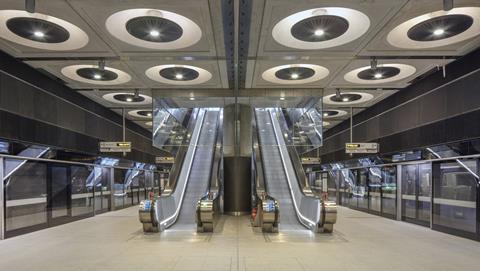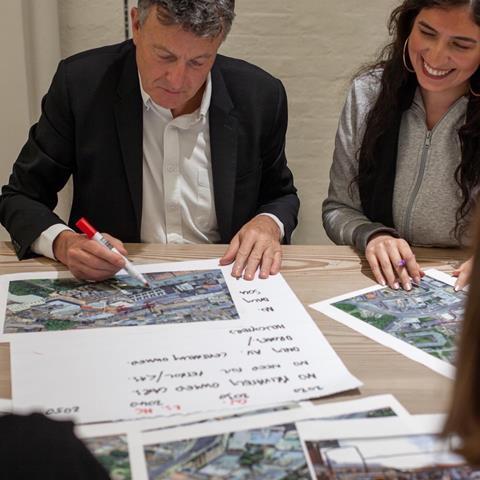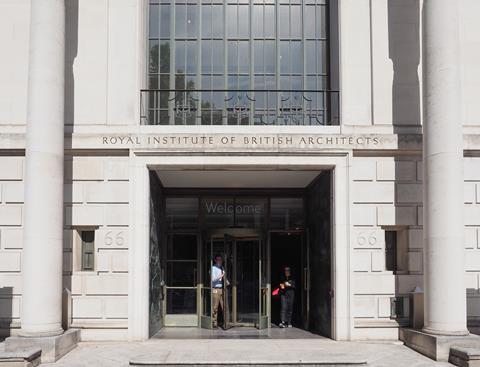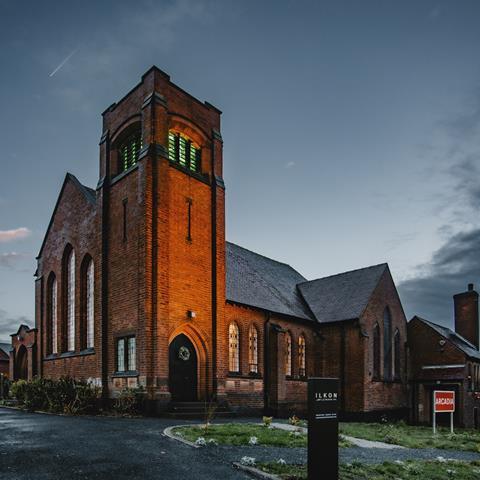Ben Flatman talks to the founder of Weston Williamson + Partners about the role RIBA has played in his career, the importance of lifelong learning, and why he wants to help the next generation of architects get a leg up in the profession

Chris Williamson is the founder of Weston Williamson + Partners, one of the UK’s best known architectural practices. Formed with fellow Leicester Polytechnic student Andrew Weston (the pair were told to work together in the design studio because their surnames were alphabetically adjacent in the register), the practice is best known for its transport infrastructure projects, including the Paddington and Woolwich stations on the Elizabeth line.
“‘You can work with Weston,’ they said to us at Leicester,” says Williamson. “And, 40 years later, we’re still working together.
“The reason we clicked was because we had compatible interests. That included a shared concern about sustainability – even at the end of the 1970s, climate change was an issue.”
Having sold the practice to Egis Group in 2022, Williamson went from being a practice owner to being an employee again. Motivated by a desire to ensure RIBA gives a new generation of architects the support he feels it gave his practice at a crucial moment in the 1980s, Williamson is running to be RIBA president from 2025-27.

Given recent changes to the RIBA organisational structure, with the board having executive control, and the president now primarily a representational role, why do you think the presidency is still important?
“Well, first of all, I think the changes were absolutely the right thing to do. You wouldn’t run a business where you were changing the chairman every couple of years, so giving more responsibility to the board makes a lot of sense.
“But, yes, I think a lot of members are concerned that they have less of a voice, and I think that’s where the president comes in – to be a voice for the members and also to promote the RIBA.
“I want to work on getting more visibility for architecture – communicating the value of architecture, locally, nationally and internationally.
My polling shows that members’ concerns are around pay, remuneration, prestige and respect
“I’ve been involved in the RIBA under several presidents in a range of different roles, going back to the early 2000s. But my concern is that nothing seems to change, and that the RIBA is sleepwalking into oblivion. I think the youngsters in our profession don’t see the relevance of a member’s club anymore.
“The only way that the RIBA can survive is for it to be seen as more of a qualification, rather than something where you just pay for a prestigious crest and the initials after your name – the initials have to stand for something.
“And the only way to do that is through lifelong learning. My polling shows that members’ concerns are around pay, remuneration, prestige and respect, but I think lifelong learning is the way to address these issues.
“Currently, you can spend an hour sitting down, watching somebody try and sell their light fittings and you can strike that off as an hour of CPD. But that doesn’t demonstrate that we are the best in the world, or that we’re fit for purpose.”
At the last presidential election in 2022, the turnout fell again to just 12.4%. Why does it appear that members are not engaging with the institute?
“I have very strong views on why RIBA matters for the members. The RIBA has been incredibly good to me and Andrew. We were selected for RIBA’s “40 under 40” exhibition in 1985, along with people like Allies and Morrison, Alsop and Lyall and Amanda Levete.
“The RIBA actually gave us a lot of encouragement at that time. They would put young architects on shortlists for projects – we had the most amazing opportunities. It was the RIBA that gave us that start and gave us those opportunities. So, I have a lot to thank the RIBA for and that’s why I’m passionate about doing this job.
“I want to make sure that for young architects it is seen as their home, their chance to progress. I think we can do a lot for young architects – they need all the help they can get at the moment.”
It sometimes appears that salaried architects look to the RIBA to provide a trade union function, while sole practitioners worry about architectural designers undercutting them on fees, and practice principals – running large practices and perhaps employing hundreds of people – have got a different set of concerns. Is there a risk that RIBA is almost set up to fail its members because it cannot actually address the needs of these different groups?
“I’ve been an employee, I’ve been a small practice owner, I’ve been a large practice owner and now I’m an employee again. And each one of them is stressful. But I really don’t like this idea that there are workers and there are business owners.
“The stress of being a business owner can be huge. When our office was 20 or 30 people, you knew intimately what was happening in everybody’s lives – you knew who was getting married, who was having children, who was moving house.

“The sleepless nights I had worrying about the people that I employed were far more stressful than when I was an employee. I’m not saying one’s better than another, but I think that this divisive attitude about workers and business owners doesn’t really get us anywhere.
“I’ve always been passionate about making sure that people are properly paid and properly rewarded, and the way to tackle this, in my opinion, is to be better. We’ve all got to be better.
“People love our design skills, but we’re not good at management. We have to get better at a whole range of other skills to convince people that we are worth paying.
“So, we need to ratchet up our skills, get better at negotiation, get better at presentation, get better at listening to clients.”
What will be your top priorities as RIBA president?
“I’ve been incredibly pleased with the support that I’ve had for my campaign. I’ve got five or six Stirling prize winners, but I’ve also got students, sole practitioners, educationalists and young architects, international architects and regional architects.
“And I need to represent them all. They all have different concerns, but everybody is passionate about their own brand of architecture or their particular interests, whether it’s heritage or conservation or sustainability.
“So, I broke my manifesto down into 10 priorities and these are just my top three: The first one is a comprehensive spending review to ensure that every penny at RIBA is spent to promote architecture for the benefit of all our RIBA members and society at large.
“Part of this would be making sure that we paired up our experts with the government ministers responsible – like Ben Derbyshire on heritage, or Alex Ely on housing and Duncan Baker-Brown on climate change. We also really need to leverage our honorary fellows. We make people honorary fellows and they’re fantastically well connected and real experts in their field and then we just forget about them and they’re telling me that they want to be more involved.
“My second priority is improved communications – between the RIBA and members and our wider community, creating an engaged global network with shared values. When I was international vice-president, I met with all the institutes – Australia, Canada, Brazil, Japan – and they all want to be associated with the RIBA.
“I think we’re pushing at an open door to create a global community for architects that we can then use to solve some of the world’s problems of urbanisation and climate change. We can’t tackle it on our own. We have to take everybody with us.
I still think the architect is the best person to be the project manager. But to be project managers – and principal designers - we have to do training and lifelong learning properly
“And my third priority is to overhaul lifelong learning, so that it would add skills and increase knowledge. This would increase remuneration and help rebuild respect.
“At the moment CPD isn’t nuanced enough. It has to be geared for where you are in your career and for your specialism. I think that you should be allowed to specialise and that then clients can choose what kind of architects they want.
“There are something like 17 different types of surveyors in the RICS chartered system, and we’re still trying to make everybody be ‘an architect’. And, in this day and age, that doesn’t work.”
Jack Pringle wrote recently that the new principal designer role was an opportunity for architects to “get back to conducting the design orchestra”. Is this an important opportunity, or is that idea of the architect as lead consultant outdated?
“I think it’s sad that it’s come to this, and I can understand members’ concerns and why they might be saying ‘that’s what we do already’. But the reason the principal designer role has been created is because we no longer had that golden thread through the construction process anymore. And so, yes, it is an opportunity.
“But there is a danger – because it’s another qualification and because it’s expensive – that architects are going to again let this opportunity slip, and that somebody else ends up filling this role.
“Back in 1985 I did an MSc in project management. I’d been working for Michael Hopkins and all of our projects were project managed by Bovis or Laing. So, as the architect, you were always divorced from the actual nitty-gritty.
I’d like to get the institute in a place where it’s approaching its 200th anniversary with confidence
“So the actual management of projects was something that I knew I needed more experience of. I did a course at the South Bank and it was one of the best things I’ve ever done.
“But there were just the two architects on the course – Morley von Sternberg and me – in a sea of surveyors and developers. So, just as we let go of the project management role, there’s a real risk we will let this principal designer opportunity slide too.
“I still think the architect is the best person to be the project manager. But to be project managers – and principal designers - we have to do training and lifelong learning properly.”
We interviewed Joe Morris a few weeks ago and he said that he finds the expectations on architects to push the retrofit agenda to be unrealistic because there’s no legislation to back them up when clients want to go for new build. What are your thoughts?
“I think it has always been difficult to get clients to focus on sustainability.
“We’ve worked for housing developers who’ve won ‘client of the year’ several times, but when we’ve tried to get them to install triple-glazing, rather than double-glazing, they’ve said, ‘it’s going to cost us £10,000 – we’re not going to do it’.
“I think it’s incumbent on us to try and get them to do it and to argue for it. But it’s also incumbent on us to try and get the legislation tightened up. So, I agree with Joe Morris – it has to be done by legislation and we have to lobby for better standards.”
Are you supportive of the House of Architecture programme?
“I am, I am! I love 66 Portland Place, but I would still like to see where the money’s being spent. It needs work doing to it, but it’s a hell of a lot of money. What I’m more interested in is what we’re going to get out of it. How’s it going to work for us?

“I’m used to running a £20m business, which is what the RIBA is, and spending £80m is an awful lot of money for that sort of turnover. Before investing that amount, ideally, I’d have preferred to see us increase membership. I’d like to get the institute in a place where it’s approaching its 200th anniversary with confidence.
“I’d like to see it in a really good place, in terms of reputation and prestige, with clients really wanting to use an RIBA architect.”
How would you connect with members outside of London?
“I bought an old church in my hometown of Ilkeston, which is in the East Midlands between Nottingham and Derby. And we engaged with the East Midlands by getting 90 architecture students to look at ways to turn Ilkeston into a creative hub.
“It’s on the train line between Nottingham and Leeds and Sheffield and a lot of the industry has disappeared. So, the question we’ve asked is, ‘how can you give a post-industrial town a new reason for being?’

“We’ve been working with Nottingham Trent University, de Montford University, and Derby. So, I’m very aware of the amazing work that there is in the regions. And the regions are just as passionate about architecture as we are in London.
“We need to give them a bit more money to be able to do their own programmes and not control everything so much from the centre.”
Is there one final thing you’d like to say to members?
“Just vote. I’m trying to do as much as I can to get people interested. And what I’ve said is that I would rather lose by 1,000 votes with a big turnout, than win by 100 on a low turnout.
“I hope that doesn’t happen [laughs], but I would like to see a bit more enthusiasm about the membership. From the polls that I’ve taken and the people that I’ve spoken to, it’s help that the members need.
“The big practices have sustainability consultants, they have business advisors, they have a legal team, but the small practices and the sole practitioners don’t.
“And that’s what the RIBA can do – we can be a family and help each other because we’ve already got those skills. So I want to concentrate on developing a community. I know that it exists in the regions and that it exists internationally as well.
“And, in order to do that, you need to have a coherent programme. Everything is connected – competitions, awards, lectures, events – and they all go together to create a brand.
“If you’ve got the right leadership team, you can do the most amazing things. And if you haven’t, it soon falls apart.
“So, I think that’s really important to me – to try and use this opportunity to rejuvenise the RIBA.”


























No comments yet